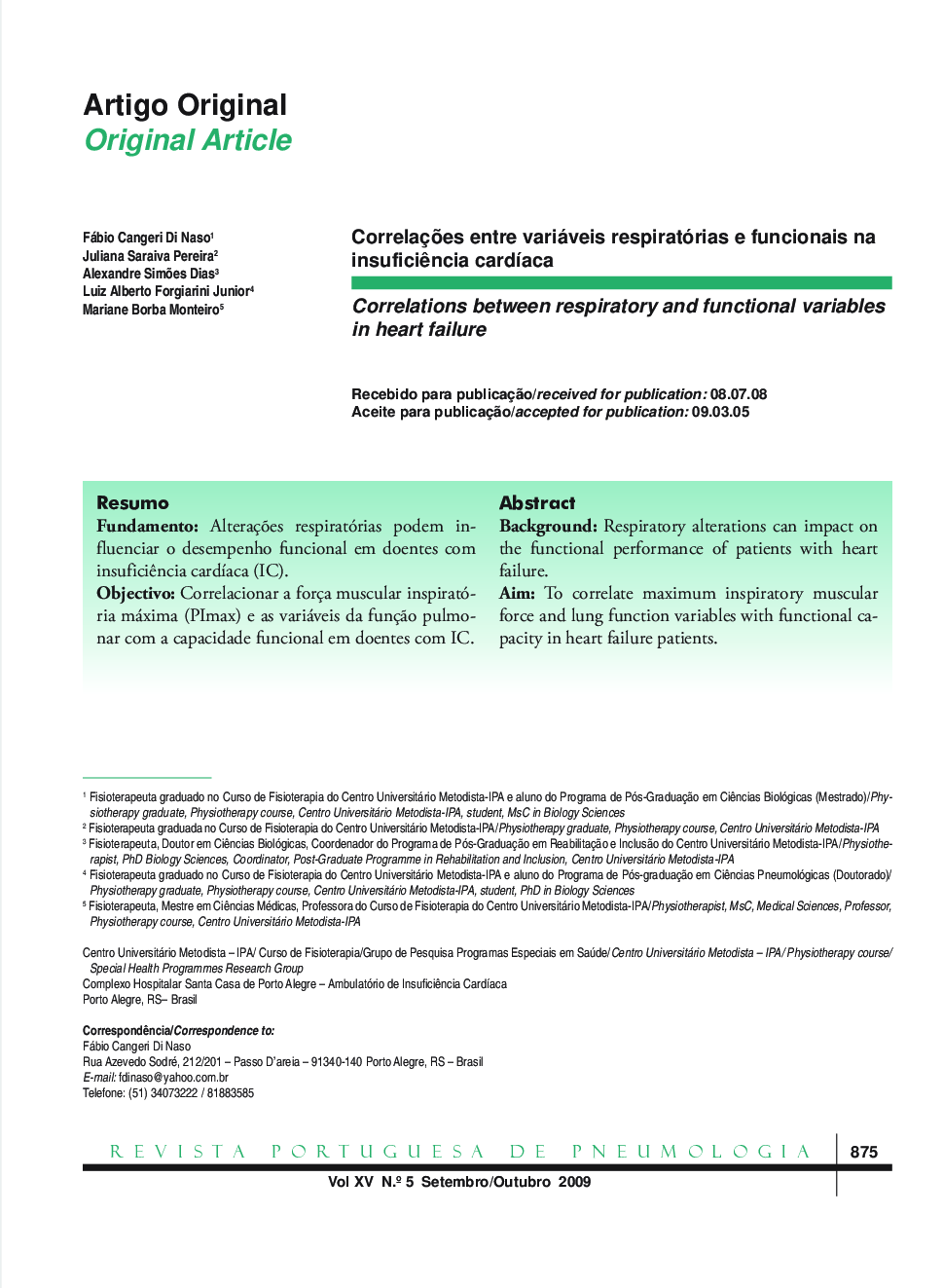| کد مقاله | کد نشریه | سال انتشار | مقاله انگلیسی | نسخه تمام متن |
|---|---|---|---|---|
| 4215218 | 1281117 | 2009 | 16 صفحه PDF | دانلود رایگان |

BackgroundRespiratory alterations can impact on the functional performance of patients with heart failure.AimTo correlate maximum inspiratory muscular force and lung function variables with functional capacity in heart failure patients.MethodsA transversal study January-July 2007 with 42 chronic heart disease patients (28 males) with no prior pulmonary illness. The patients were in New York Heart Association Functional Class I, II and III. The variables used were maximum inspiratory pressure, forced vital capacity and forced expiratory volume in the first second. Respiratory variables measured were distance covered in the six-minute walk test, NYHA functional class and the physical functioning domain of the Short Form-36 Quality of Life Questionnaire.ResultsMaximum inspiratory pressure correlated with the six-minute walk test (r = 0.543 and p < 0.001), functional capacity (r = −0.566 and p < 0.001) and the physical functioning domain score of the Short Form-36 (r = 0.459 and p = 0.002). The same was true of forced vital capacity and the six-minute walk test (r = 0.501 and p = 0.001), functional capacity (r = −0.477 and p = 0.001) and Short Form-36 (r = 0.314 and p = 0.043) variables. Forced expiratory volume correlated with the distance covered in the six-minute walk test (r = 0.514 and p < 0.001) and functional capacity (r = −0.383 and p = 0.012).ConclusionLung function and inspiratory muscular force respiratory variables correlated with functional variables in patients with heart failure.
ResumoFundamentoAlterações respiratórias podem influenciar o desempenho funcional em doentes com insuficiência cardíaca (IC).ObjectivoCorrelacionar a força muscular inspiratória máxima (PImax) e as variáveis da função pulmonar com a capacidade funcional em doentes com IC.MétodosEstudo transversal realizado de Janeiro a Julho de 2007 incluindo 42 doentes com IC crónica (28 homens) que não apresentavam doença pulmonar prévia. Os doentes pertenciam às classes funcionais I, II e III segundo a NYHA (New York Heart Association). As variáveis respiratórias mensuradas foram a PImax, a CVF (capacidade vital forçada) e o VEF1(volume expiratório forçado no 1.° segundo). A distância percorrida no teste da caminhada dos seis minutos (TC6M), a classe funcional (CF) e o domínio referente à capacidade funcional do questionário de qualidade de vida Short Form-36 (SF-36) foram as variáveis funcionais utilizadas.ResultadosA PImax correlacionou-se com a TC6M (r = 0,543 e p<0,001), com a CF (r = −0,566 e p < 0,001) e com a pontuação do domínio capacidade funcional do SF-36 (r = 0,459 e p = 0,002). O mesmo ocorre com a CVF e as variáveis TC6M (r = 0,501 e p = 0,001), CF (r = −0,477 e p = 0,001) e SF-36 (r = 0,314 e p = 0,043). O VEF1 apresentou correlação com a TC6M (r = 0,514 e p < 0,001) e com a CF (r = −0,383 e p = 0,012).ConclusãoVariáveis respiratórias referentes à função pulmonar e à força muscular inspiratória correlacionam com variáveis funcionais em doentes com IC.
Journal: Revista Portuguesa de Pneumologia (English Edition) - Volume 15, Issue 5, September–October 2009, Pages 875-890